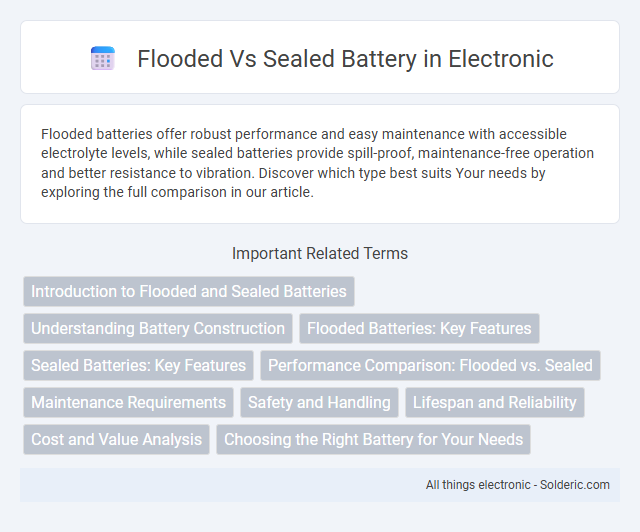Flooded batteries offer robust performance and easy maintenance with accessible electrolyte levels, while sealed batteries provide spill-proof, maintenance-free operation and better resistance to vibration. Discover which type best suits Your needs by exploring the full comparison in our article.
Comparison Table
| Feature | Flooded Battery | Sealed Battery |
|---|---|---|
| Design | Open cell; requires maintenance | Closed cell; maintenance-free |
| Maintenance | Requires regular water refilling | No water refilling needed |
| Lifespan | 3-5 years | 4-7 years |
| Cost | Lower initial cost | Higher initial cost |
| Performance | Better suited for deep cycles | Good for starting and standby power |
| Safety | Potential acid spillage or gas emission | Sealed design reduces spillage and emissions |
| Application | Solar systems, forklifts, golf carts | UPS, emergency lighting, vehicles |
Introduction to Flooded and Sealed Batteries
Flooded batteries use a liquid electrolyte to facilitate chemical reactions, requiring regular maintenance such as topping off with distilled water to prevent damage and ensure optimal performance. Sealed batteries, including AGM and gel variations, contain immobilized electrolytes, offering maintenance-free operation and better resistance to vibration and spillage. The choice between flooded and sealed batteries depends on application needs, environmental conditions, and maintenance capabilities.
Understanding Battery Construction
Flooded batteries feature liquid electrolyte that submerges the plates, allowing for easy maintenance through electrolyte replenishment and offering robust durability for deep-cycle applications. Sealed batteries, also known as Valve-Regulated Lead-Acid (VRLA) batteries, use immobilized electrolyte in gel or absorbed glass mat (AGM) form, reducing maintenance needs and preventing electrolyte leakage. Understanding this key difference in battery construction helps you choose the right battery type based on your maintenance preferences and usage requirements.
Flooded Batteries: Key Features
Flooded batteries are characterized by their use of a liquid electrolyte solution that requires regular maintenance such as topping off with distilled water to prevent damage and ensure optimal performance. They are cost-effective, have a robust design, and are highly tolerant to overcharging and deep discharges, making them suitable for applications like solar energy storage and off-grid systems. While flooded batteries offer long cycle life and high surge currents, their maintenance needs and susceptibility to spillage limit their use in sealed or portable environments.
Sealed Batteries: Key Features
Sealed batteries, also known as maintenance-free batteries, feature a spill-proof design that prevents acid leakage and reduces the risk of corrosion, making them safer for indoor use and transportation. These batteries typically employ absorbed glass mat (AGM) or gel technology, which enhances their vibration resistance and allows for faster charging cycles compared to flooded batteries. You benefit from lower maintenance requirements and improved performance in applications such as renewable energy systems, backup power, and electric vehicles.
Performance Comparison: Flooded vs. Sealed
Flooded batteries deliver reliable performance with excellent tolerance to overcharging and lower upfront costs, making them ideal for heavy-duty applications requiring frequent maintenance access. Sealed batteries, including AGM and gel types, offer superior resistance to vibration, maintenance-free operation, and better performance in sealed environments, enhancing safety and convenience for your energy storage needs. Comparing cycle life and efficiency, sealed batteries generally provide longer service life and more consistent discharge rates, while flooded batteries excel in cost-effectiveness and ease of repair.
Maintenance Requirements
Flooded batteries require regular maintenance, including checking electrolyte levels and topping up with distilled water to prevent damage. Sealed batteries are maintenance-free, as they are designed to be leak-proof and do not require water refills. Your choice depends on how much time you can dedicate to upkeep and whether you prefer a hassle-free battery system.
Safety and Handling
Flooded batteries require regular maintenance to check electrolyte levels and prevent acid spills, posing higher safety risks during handling due to potential leaks and corrosion. Sealed batteries, such as AGM and gel types, offer enhanced safety by being spill-proof and reducing acid exposure, making them easier and safer to handle in various environments. Proper protective gear and adherence to safety protocols are essential for both types to prevent injury and equipment damage.
Lifespan and Reliability
Flooded batteries typically offer a longer lifespan due to easier maintenance and the ability to equalize cells, which helps prevent sulfation and extends overall battery health. Sealed batteries, such as AGM or gel types, provide enhanced reliability by being maintenance-free and resistant to leaks, making them ideal for applications where consistent performance is critical. Your choice between flooded and sealed batteries should balance lifespan requirements with maintenance capabilities and environmental conditions to maximize durability and reliability.
Cost and Value Analysis
Flooded batteries typically have a lower initial cost and are easier to maintain, making them a cost-effective choice for budget-conscious users seeking value in long-term use despite periodic maintenance expenses. Sealed batteries, such as AGM or gel types, carry a higher upfront price but offer enhanced durability, reduced maintenance, and better performance in extreme conditions, delivering greater overall value for applications where reliability and minimal upkeep are critical. The choice between flooded and sealed batteries hinges on balancing short-term savings against long-term efficiency and operational costs.
Choosing the Right Battery for Your Needs
Flooded batteries offer cost-effective power with easy maintenance and are ideal for applications requiring high surge currents, such as automotive and solar setups. Sealed batteries, including AGM and gel types, provide leak-proof, maintenance-free operation suitable for portable electronics, UPS systems, and environments sensitive to spills. Selecting the right battery depends on factors like budget, maintenance willingness, space constraints, and specific power requirements.
Flooded vs sealed battery Infographic

 solderic.com
solderic.com